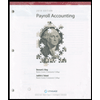
Accounting Information Systems
11th Edition
ISBN: 9781337676557
Author: Ulric J. Gelinas; Richard B. Dull; Patrick Wheeler
Publisher: Cengage Learning US
expand_more
expand_more
format_list_bulleted
Question
Chapter 14, Problem 13RQ
Summary Introduction
To list: The major logical functions of the payroll process.
Introduction:
Human resource (HR) management and Payroll process:
Human resource management is about the basic human management functions in an organization and its associated activities. It also speaks about the relationship between human resource management activities and the payroll process. It also depicts the importance of HR activities in the decision making of the top management.
Expert Solution & Answer
Want to see the full answer?
Check out a sample textbook solution
Students have asked these similar questions
Need answer.
Solve plz now
Precious metal qn solve .
Chapter 14 Solutions
Accounting Information Systems
Ch. 14 - What is human capital management (HCM)?Ch. 14 - What does human capital include?Ch. 14 - What is the human resources management process?...Ch. 14 - Prob. 4RQCh. 14 - Prob. 5RQCh. 14 - What role does each HR manager listed in Figure...Ch. 14 - What key decisions do the HR managers shown in...Ch. 14 - Prob. 8RQCh. 14 - Prob. 9RQCh. 14 - Prob. 10RQ
Ch. 14 - Prob. 11RQCh. 14 - Prob. 12RQCh. 14 - Prob. 13RQCh. 14 - Prob. 14RQCh. 14 - Prob. 15RQCh. 14 - Prob. 16RQCh. 14 - Prob. 17RQCh. 14 - Prob. 1DQCh. 14 - Prob. 2DQCh. 14 - Discuss the role unions and government agencies...Ch. 14 - Prob. 4DQCh. 14 - Prob. 5DQCh. 14 - In this chapter, we stated that many organizations...Ch. 14 - Prob. 3SPCh. 14 - Prob. 4SPCh. 14 - Prob. 5SPCh. 14 - Prob. 6SPCh. 14 - Prob. 6PCh. 14 - Prob. 7P
Knowledge Booster
Similar questions
arrow_back_ios
SEE MORE QUESTIONS
arrow_forward_ios
Recommended textbooks for you
 College Accounting (Book Only): A Career ApproachAccountingISBN:9781337280570Author:Scott, Cathy J.Publisher:South-Western College Pub
College Accounting (Book Only): A Career ApproachAccountingISBN:9781337280570Author:Scott, Cathy J.Publisher:South-Western College Pub Accounting Information SystemsAccountingISBN:9781337619202Author:Hall, James A.Publisher:Cengage Learning,
Accounting Information SystemsAccountingISBN:9781337619202Author:Hall, James A.Publisher:Cengage Learning,- Principles of Accounting Volume 1AccountingISBN:9781947172685Author:OpenStaxPublisher:OpenStax College

 Cornerstones of Financial AccountingAccountingISBN:9781337690881Author:Jay Rich, Jeff JonesPublisher:Cengage Learning
Cornerstones of Financial AccountingAccountingISBN:9781337690881Author:Jay Rich, Jeff JonesPublisher:Cengage Learning

College Accounting (Book Only): A Career Approach
Accounting
ISBN:9781337280570
Author:Scott, Cathy J.
Publisher:South-Western College Pub

Accounting Information Systems
Accounting
ISBN:9781337619202
Author:Hall, James A.
Publisher:Cengage Learning,


Principles of Accounting Volume 1
Accounting
ISBN:9781947172685
Author:OpenStax
Publisher:OpenStax College


Cornerstones of Financial Accounting
Accounting
ISBN:9781337690881
Author:Jay Rich, Jeff Jones
Publisher:Cengage Learning